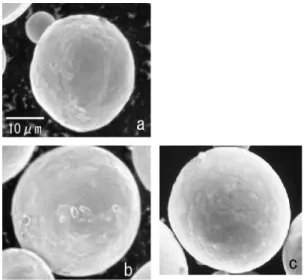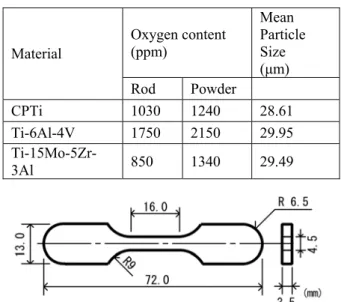© Korean Powder Metallurgy Institute 771
-1. Introduction
Ti and Ti alloy are widely used for their high specific strength, superior corrosion resistance, heat resistance and biocompatibility. Metal Injection Molding (MIM) process enables mass production of parts with complex shape and accuracy. MIM is available for mass production of Ti and Ti alloy parts. Using powder with low oxygen content is significant to obtain reliable parts. Generally pure metal powder with high activity is produced by gas atomization. Metal powder made by especially Electrode Induction-melting Gas Atomization (EIGA) contains little impurities because of contactless melting and atomizing. Such active material is easily contaminated by oxygen and other impurities from atmosphere and setters during MIM process. Mechanical properties and reliability of metal injection molded Ti and Ti alloy parts are infuluenced1).
Therefore preventing contamination of oxygen during MIM process is also significant2). On the other hand, tensile
strength of Ti alloy shows a density dependence strongly3). Thus high relative density should be reached for good mechanical properties.
2. Experimental and Results
Commercial Pure Ti (CPTi) , Ti-6Al-4V and Ti-15Mo-5Zr-3Al rods were induction-melted and atomized. Fig.1. shows the atomized powders. The atomized powders were sieved to 45µm. The powders under 45µm were used for MIM.
Fig. 1. SEM images of the atomized powders for MIM. (a) CPTi, (b) Ti-6Al-4V, (c) Ti-15Mo-5Zr-3Al.
Table 1 shows oxygen content of the rods and atomized powders, and mean particle size of the powders used for MIM. The obtained powders were mixed with polymer binder and wax by using a pressurized kneader to form feedstock. The feedstock was injection molded into tensile specimens shown in Fig.2. After solvent extraction, sintering was performed. Characteristics of the specimens were accomplished by density measurements and tensile tests. In addition, carbon content and oxygen content of the specimens were measured to evaluate their soundness. 2006 POWDER METALLURGY
World Congress
B02-09-2
Effect of Oxygen on Mechanical Properties of Metal Injection
Molded Titanium and Titanium Alloy
Kenji Doi1,a, Kazuki Hanami1,b, Hideki Tanaka1,c, Tsuneo Teraoka1,d, and Shuntaro Terauchi1,e 1
Osakayakinkogyou Co., Ltd. 4-4-28 Zuiko, Higashiyodogawa-ku, Osaka 533-0005, Japan
a doi@e.osakayakin.co.jp, bhanami@e.osakayakin.co.jp, c tanaka@e.osakayakin.co.jp, dteraoka@e.osakayakin.co.jp, e terauchi@e.osakayakin.co.jp Abstract
Mechanical properties of metal injection molded titanium and titanium alloy parts were investigated in this study. Material powders with low oxygen content and spherical shape were obtained by electrode induction-melting gas atomization which could melt and atomize titanium and titanium alloy bars with no touch on crucible or tundish. Tensile specimens were fabricated from obtained powders by metal injection molding process. Tensile strength of the specimens increases with increasing oxygen content. This result corresponds to a tendency of wrought metal.
© Korean Powder Metallurgy Institute 772 -Table 1. Oxygen content of the rods and atomized powders, and mean particle size of the powders used for MIM.
Oxygen content (ppm) Mean Particle Size (µm) Material Rod Powder CPTi 1030 1240 28.61 Ti-6Al-4V 1750 2150 29.95 Ti-15Mo-5Zr-3Al 850 1340 29.49
Fig. 2. Dimensions of the specimens for tensile tests.
Tensile strength and elongation of the CPTi specimens are plotted against oxygen content in Fig.3. Tensile strength increases with increasing oxygen content. This result corresponds to a tendency of wrought metal.
Fig. 3. Effect of oxygen content on the tensile strength of injection molded CPTi.
Table 2 shows the mechanical properties of Ti-6Al-4V and Ti-15Mo-5Zr-3Al specimens as sinter. High relative density of more than 95% was obtained. Carbon content of the Ti-6Al-4V and Ti-15Mo-5Zr-3Al specimens is 460ppm and 650ppm respectively. This indicates that polymer binder is well debound. Metal injection molded Ti-6Al-4V and Ti-15Mo-5Zr-3Al stand comparison with wrought metal in tensile strength and elongation. These results show that reliable Ti and Ti alloy parts can be obtained by MIM process.
Table 2. Mechanical properties of the metal injection molded Ti-6Al-4V and Ti-15Mo-5Zr-3Al as sinter. Material Oxygen content (ppm) Relative density (%) Tensile strength (MPa) Elongation (%) Ti-6Al-4V 2510 96.3 927 14.7 Ti-15Mo-5Zr-3Al 1940 97.4 877 5.3 3. Conclusions
CPTi, Ti-6Al-4V and Ti-15Mo-5Zr-3Al powders were made by EIGA to obtain material powder which contains little impurities. Tensile specimens were made from atomized powder. Then mechanical properties of injection molded Ti, Ti-6Al-4V and Ti-15Mo-5Zr-3Al were investigated in this study. The results are as follows.
(1) CPTi, Ti-6Al-4V and Ti-15Mo-5Zr-3Al powders with low oxygen content were obtained by EIGA.
(2) Tensile strength of metal injection molded CPTi increases with increasing oxygen content. This result corresponds to a tendency of wrought metal.
(3) Tensile strength and elongation of the injection molded Ti-6Al-4V and Ti-15Mo-5Zr-3Al as sinter are 927MPa, 14.7% and 877MPa, 5.3% respectively. Metal injection molded Ti-6Al-4V and Ti-15Mo-5Zr-3Al stand comparison with wrought metal in mechanical properties.
4. References
1. K. Maekawa, M. Takita and H. Nomura: J. Jpn Soc. Powder and Powder Metallurgy, 46, pp. 1053-1057(1999)
2. JA Grohowski, B. Sherman, JT Strauss: Adv Powder Metall Part Mater, pp. 273-281(2003)
3. H. Miura, T. Teruie, Y. Kuwano, Y. Ito, K. Sato: Abstract of Spring Meeting Jpn Soc. Powder and Powder Metallurgy, p. 100(2006)

